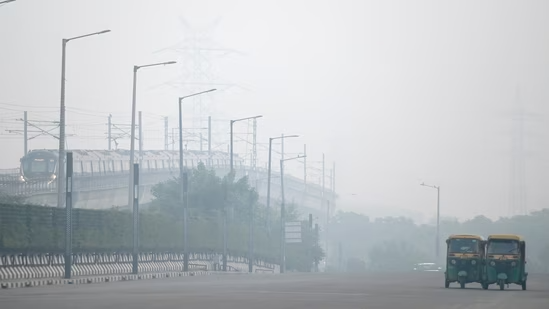The air quality narrative in Delhi and its periphery took a negative turn overnight, losing ground despite a slight improvement just 24 hours prior. Future projections indicate no imminent relief on the horizon.
According to reports, at 8 am on Monday, the city’s Air Quality Index (AQI) recorded a downturn, measuring 338—an unfavorable shift from 301 at 4 pm and 290 at 7 am on Sunday.
The 24-hour average AQI, evaluated at 4 pm daily, displayed a rollercoaster trajectory, reaching 319 on Saturday, 405 on Friday, and 419 on Thursday.
Neighboring regions, encompassing Ghaziabad (306), Gurugram (239), Greater Noida (288), Noida (308), and Faridabad (320), also experienced a decline in air quality.
An AQI falling between zero and 50 is considered ‘good,’ while 51 to 100 is ‘satisfactory.’ Progressing up the scale, 101 to 200 is ‘moderate,’ 201 to 300 is ‘poor,’ 301 to 400 is ‘very poor,’ and 401 to 450 is ‘severe.’ Beyond 450 marks the ominous ‘severe plus.’
Despite the relaxation of stringent measures over the weekend, such as the ban on construction and entry of polluting trucks into Delhi, implemented in the final stage, Stage IV, of the Graded Response Action Plan (GRAP) due to favorable wind conditions, the air quality did not see significant improvement.
The Commission for Air Quality Management, however, urged Delhi and NCR states to uphold certain restrictions, underscoring the significance of pollution control. Of particular concern is vehicular emissions, which contribute to approximately 36% of pollution.
Delhi’s Environment Minister, Gopal Rai, stressed the need for vigilance, recalling the setback caused by Diwali firecrackers. While certain restrictions have eased, others under stages I, II, and III of GRAP persist, highlighting the delicate equilibrium in the ongoing battle against Delhi’s air quality challenges.
Delhi’s Lingering ‘Very Poor’ Air Quality Raises Health Concerns as Schools Reopen
Delhi, grappling with ‘very poor’ air quality, faces renewed health concerns as schools resume post an early winter break. The Air Quality Index (AQI) soared, with Punjabi Bagh registering the highest AQI at 418, closely followed by Bawana (414) and Jahangirpuri (402), all falling into the ‘severe’ category.
Dr. Randeep Guleria, former director of AIIMS, sounded a dire warning amidst the escalating air pollution crisis in Delhi-NCR. Terming air pollution a ‘silent killer’ that exacerbates existing health issues and triggers concealed health problems, Dr. Guleria stressed the urgency of addressing this medical emergency, even if the associated costs are substantial. In an interview with The Indian Express, he underscored the need to learn from effective solutions implemented elsewhere.
While discussing indoor air pollution and mitigation strategies, Dr. Guleria emphasized the necessity for comprehensive data on the efficacy of air purifiers. He elucidated that factors such as room dimensions and ventilation play a pivotal role in determining their effectiveness.
“In many houses in Delhi, rooms are not airtight, and pollution can still infiltrate even if you close the door. Therefore, when using an air purifier, its effectiveness is contingent on the room size and the degree of ventilation,” Dr. Guleria elaborated.
The veteran pulmonologist also shed light on the far-reaching consequences of air pollution across various age groups. He cited studies revealing stunted lung growth in children and heightened risks of stroke, heart attacks, and dementia in the elderly. Dr. Guleria’s insights underscore the multifaceted impact of air pollution on public health, urging prompt and concerted efforts to mitigate its detrimental effects.

